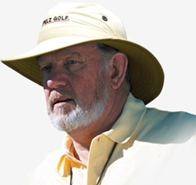Dave Pelz is a world-class content marketer. In fact, the nominating committee here at TPC has decided to induct Pelz into our just-now-opened Touch Point City Hall of Fame.

Dave Pelz, golf guru and content marketer extraordinaire
If you play or follow golf, you know Pelz as the sport’s premier short-game teacher and guru. A veritable Wizard of the Wedge. The Grand Pooba of Putting.
Indeed, Pelz has made himself into a global, vertically integrated golf instruction brand. Among other things he:
- Coaches pros and top amateurs on putting, chipping and pitching.
- Operates name-branded golf schools and clinics around the world.
- Conducts and publishes research.
- Authors (or applies his expertise and brand to) instruction books, videos, a Web site, and how-to articles in Golf magazine.
- Appears often to dispense analysis on Golf Channel TV.
Whether he views himself as such or not, Pelz is a content marketer. In fact, how he approaches his craft holds lessons for all of us on leveraging content to build brand and create following. Here are six Pelz-inspired tips:
1. Focus on a precise target, then commit to the shot.
Pelz is not a golf instructor. He’s a short-game guru. Major distinction. Take a somewhat narrow category (golf), one occupied by other brands (golf pros and coaches). Now, carve an even narrower niche, where you can focus, differentiate, and thus be more likely to achieve thought-leader status.
Similarly, in a field such as IT strategy and infrastructure, a consultant wanting to build a brand would be wise to focus on a particular area — e.g., identity management, legal e-discovery — than be one among hundreds or even thousands generically cranking out Webinars and white papers across a spectrum of IT topics.
2. Grip down on your subject matter.
I’m surprised at how often I hear marketers underestimate audience interest in deep-dive content. “People just aren’t going to read that much,“ is the oft-cited reasoning.
I fear the outcome of that attitude tends to favor tried-and-true promotional messaging or surface-level storytelling. And guess what? People aren’t going to read that much.
Clearly Pelz doesn’t share the concern. In fact, his work suggests that once you decide on a niche, dare to delve into the nitty-gritty. Assuming you’ve gauged the audience and the subject-matter depth and breadth correctly, dive deep — and trust they’ll follow.
In Golf‘s March 2009 issue, Pelz and co-author David DeNunzio offer a six-page, photo-rich feature on wedge play. But not just any wedge play. Their feature drills way down on generating effective spin. It describes the adverse impact grass blades have on spin. And how the two most common golf ball cover materials influence spin.
In one call-out, they even advise catching the ball on grooves 3 through 6 of a wedge’s face to create optimum spin. Now that’s long-tail content!? Pelz clearly believes people who are passionate about a sport — or any topic — value grit, not gloss.
3. Vary your club selection and approach.
Pelz, and the editors and designers at Golf, recognize that content can be deep, rich, even arcane — without being long and droning. It’s all about providing the audience with multiple entry points.
In the March feature, Pelz guides readers through a helpful thought-model for perfecting wedge spin (Swing Quality + Ball Type + Groove Structure = Backspin). There’s a “5 Reasons Why You Need More Spin” sidebar. Photo vignettes show a common backswing fault, plus three set-up, body position and practice tips.
No copy block looks more than 175 words long. But readers go away feeling they’ve digested a book chapter’s worth of insight and ideas.
4. Use all the clubs in the bag.
As noted above, Pelz is all over delivering content in multiple media formats. Video. Books. Articles. Quizzes. Practice aids and tools. Expert commentary.
5. Become a student of the game.
To his credit, many of Pelz’s teachings and practice drills are based on empirical research, not merely his own feel and talent for the game. His Pelz Institute conducts both practice range/green and statistical studies, seeking patterns and root causes among shots — lots of shots — struck poorly and well by low- and high-handicap players alike.
It’s this “science inside the swing” that, in part, accounts for Pelz’s guru status and credibility. Meanwhile, it also helps fuel and enrich his ongoing content-generation process.
6. Take feedback from each shot.
At the end of the March feature, Pelz invites readers to complete a questionnaire (either by mail or online) to indicate whether and how they plan to change their approach to hitting wedges, based on the content provided.
In fact, he sounds as though he welcomes the feedback. And that he’ll use it to enrich the ongoing dialogue and learning in which he and his short-game disciples are engaged.
Congratulations, Professor Pelz. You’re a Touch Point City Hall of Famer!
Now, I wonder if you wouldn’t mind taking a look at my putting stroke…
Photo credit www.pelzgolf.com.